#usgs native bee inventory and monitoring lab
Explore tagged Tumblr posts
Text
**URGENT** HELP SAVE THE USGS BEE LAB!
PLEASE circulate this as widely as possible, as soon as possible.
Hi all, you may not know me but I am a native bee researcher in the eastern US. People like me work to study and protect the 3600 species of native bees in North America, many of which are in severe decline.
We just received devastating news, that unfortunately was not surprising. The Trump administration's proposed 2026 budget is set to defund most of the ecological research happening at the USGS, and that includes zeroing out the budget for the USGS Native Bee Inventory & Monitoring Lab.
Don't know them? Maybe you've seen stunning photos like this:

These gorgeous and evocative focus-stacked photos of native bees on black backgrounds - all of which are public domain - come from the USGS Bee Lab (here's their Flickr). Through these, they've helped bring the beauty and importance of native bees to the public's attention. Hundreds if not thousands of news articles, videos, and publications use these photos.
But that is just one tiny slice of what the USGS Bee Lab does for pollinator conservation. Its primary role is much bigger; they provide technical support, research collaborations, and financial & grant partnerships to federal and state agencies, academic institutions and researchers, and much more, so we can study, manage, and protect North America's wild pollinators. They conduct research of their own that has led to species rediscoveries, and produce invaluable resources that have greatly advanced our understanding of wild bees and our approaches to studying and conserving them. They also provide the essential and irreplaceable service of bee identification. For those who don't know, identifying bees is hard. Sometimes Really Hard. And this lab is one of just a handful of places in the entire country who can identify some of the toughest groups of bees, and who sit on the forefront of breakthroughs on taxonomy and identification that the rest of us in this field rely on. Without this service, agencies and researchers trying to survey and monitor bees in order to track population declines, manage land, and get policy changed are stuck with a lot of nameless bees, severely limiting the usefulness of that data.
Tens of thousands, if not hundreds of thousands, of bee specimens pass through this lab annually, plus the thousands in permanent storage, from long-term monitoring efforts by state and federal agencies, and researchers like myself. They operate at a greater capacity than basically any other institution doing this kind of work. Few if any bee researchers in the eastern US, or even the country, have not benefitted from this lab's work, and those benefits are passed on to you through being able to protect pollinators and the services they provide both in agriculture and ecosystems.
This lab is headed up by scientist Sam Droege, who has dedicated decades of his life to this cause, and whom I consider not just a research partner but, humbly, a friend. I am utterly indebted to him for helping me get my start in this field, and for the support and kindness he has shown me and every other young professional who is passionate about pollinators. The Lab operates with an insanely small budget already, and a very limited staff, yet the impact they have is exponentially outsized. Losing the USGS Bee Lab would be a devastating blow to pollinator conservation in this country, at a time when native bee species are sitting on the precipice, and sustainable agriculture is non-negotiable for our future.
You can read more about the Bee Lab here. The Lab is not well-publicized, but it's a lifeline for the many dedicated people who work to try and protect pollinators and the environment at large.
SO WHAT CAN YOU DO?
Sam Droege has sent out a request for help, and has encouraged us to post on social media. This is what he wants you to do to help us save the Bee Lab.
This is verbatim:
What is Happening: · The USGS Bee Lab is at risk of being permanently closed due to cuts in the 2026 Federal Budget and looming federal RIF’s · Specifically, the Ecosystem Mission Area (EMA) budget, which funds the USGS Bee Lab and the Eastern Ecological Science center has been zeroed out · Thousands of layoffs to hit Interior, National Parks imminently - Government Executive What you can do · Write to your representatives, the White House, and the Department of the Interior that they should restore the funding for the USGS Bee Lab · Send digital or physical letters, write emails, post to social media What you should be highlighting: · Personal anecdotes about how the Bee Lab has impacted you or your organization · How important the research the Bee Lab is conducting is to your state Contact Information: 1. Representatives: Find Your Representative | house.gov 2. Senators: U.S. Senate: Contacting U.S. Senators 3. White House: Contact Us – The White House 4. Interior: [email protected] Send a copy of the letter to [email protected] Pass this email around. Post your response to social media
IT'S OK if you are not a scientist and have not directly interacted with the Bee Lab. Have you seen the lab's photos? Are you concerned about native pollinator declines? Are you aware of any pollinator conservation initiatives or policies in your own state - those almost certainly have drawn, directly or indirectly, from work the Lab has done. Speak about American food production and agriculture, how the Lab's research and collaborations are essential to safeguarding pollination services (this might help reach across the aisle).
Sam urges that these letters, emails, phone calls, etc, must happen quickly - within the next couple days. This information went out on May 8th and that is the day I am posting this. So please, don't wait.
If 'save the bees' has ever meant anything to you, this is the agency that is playing one of the biggest roles in this country in making that happen. Please, contact your representatives, and pass this call to action along however you can. Thank you.
#bees#native bees#pollinators#native pollinators#save the bees#usgs bee lab#usgs native bee inventory and monitoring lab#yes sam put his email out there so i'm going to post it as is#i just visited the lab in person a couple weeks ago and they're scrambling to get bee specimens in storage and out the door#i had that sinking feeling that i had to get my bees identified as soon as possible or i might not get the chance and here we are#i told him I'd help him in whatever way I can and so for his sake and mine please help us.#if you're a science blog and follow me PLEASE spread this around#time is of the essence. post on other platforms.#want something specific to mention? they rediscovered the chestnut mining bee. there's a smithsonian article that just came out#all about that. so you know. that was KIND OF A BIG DEAL#they also literally developed THE standardized protocol for bee monitoring. used by federal agencies and researchers alike.#THEY ARE THE BEE PEOPLE. THE BEEPLE. THE GOAT. THE OG
542 notes
·
View notes
Photo
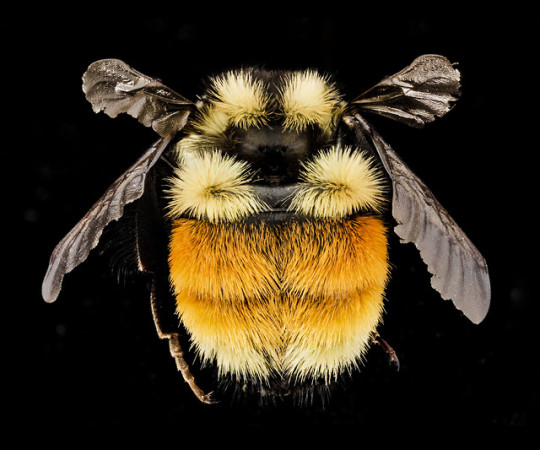
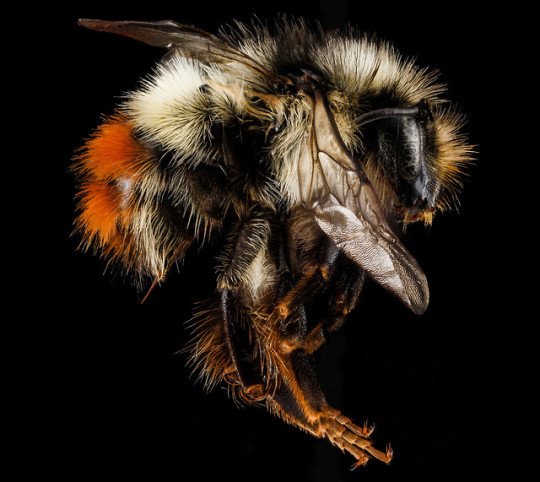
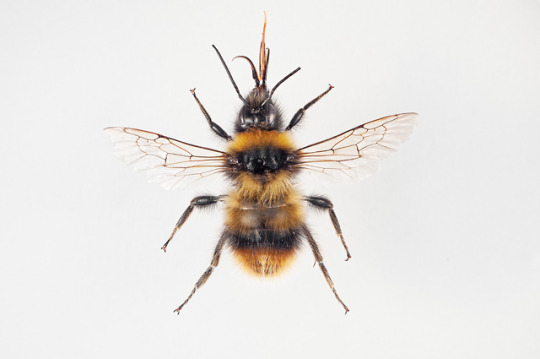
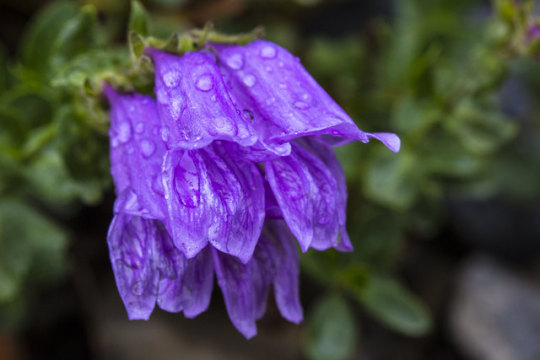
Catch the buzz! It's Pollinator Week and here in Glacier we are lucky to have a plethora of pollinators. This includes a brain-boggling 22 species of native bumblebees. The entire state of Montana boasts 28 species of the genus Bombus, more than any other state in the country!
Bumblebees are eusocial insects, or insects living in colonies run by a single queen. Females have concave regions (‘baskets’) on their hind legs that allow them to collect pollen, which is then fed to their offspring. Males transport pollen that clings to their bodies, but they don’t collect it intentionally. Both male and female bumblebees eat nectar and pollen. Pollen is high in protein and typically eaten by the queen and her larvae. Nectar provides high-energy carbohydrates, sucked down by worker bees.
Now let’s get to know some of Glacier’s bumblebees!
Photo 1: Bombus ternarius, Tri-colored Bumblebee. Found widespread throughout Canada and in the northern U.S. They prefer to nest underground in existing holes. One of their favorite plants to forage? Vaccinium, the group that includes huckleberries.
Photo 2: Bombus flavifrons, Yellowhead Bumblebee. Distributed throughout Canada and the U.S. Rocky Mountains. Queen yellowheads sometimes fall prey to cuckoo bumblebees. The latter are brood parasites that usurp the queen and trick the whole colony into raising their own offspring!
Photo 3: Bombus balteatus, High-country Bumblebee. This rare bee lives at high elevations, mostly at treeline but also in the Arctic tundra. With its long tongue, it is adapted to visit alpine flowers with long petals, such as Rocky Ledge Penstemon.
Photo credits-- 1 and 2 by USGS Bee Inventory and Monitoring Lab, Photo 3 by Arnstein Staverløkk/Norsk institutt for naturforskning, Photo 4: NPS
[Image descriptions: Photo 1: Macro overhead view of an orange and yellow fuzzy bumblebee with black wings. Photo 2: Macro side view of a bumblebee with a bright orange butt. Photo 3: Macro overhead view of yellow-and-black striped bumblebee with long tongue. Photo 4: Closeup of bright purple flowers with long tubelike petals]
37 notes
·
View notes
Video
Coelioxys novomexicana, f, right, Yolo, CA_2019-03-22-07.22.26 ZS PMax UDR by USGS Bee Inventory and Monitoring Lab Via Flickr: Coelioxys....invader of Megachile nests. This female is designed to slice into Meg nests and insert and egg which later will kill the baby leaf cutter and consume the food. This one is from the Southwest, Coelioxys novomexicana. This bee was collected in the California Central Valley in Yolo County for research on small-scale restoration in agricultural areas. Claire Kremen's 10-year study of hedgerows shows the benefits of planting native shrubs and forbs in agricultural areas for native bees. To learn more about the Kremen Lab and hedgerows, see nature.berkeley.edu/kremenlab/ Photo by Erick Hernandez ~~~~~~~~~~{{{{{{0}}}}}}~~~~~~~~~~ All photographs are public domain, feel free to download and use as you wish. Photography Information: Canon Mark II 5D, Zerene Stacker, Stackshot Sled, 65mm Canon MP-E 1-5X macro lens, Twin Macro Flash in Styrofoam Cooler, F5.0, ISO 100, Shutter Speed 200 We Are Made One with What We Touch and See We are resolved into the supreme air, We are made one with what we touch and see, With our heart's blood each crimson sun is fair, With our young lives each spring impassioned tree Flames into green, the wildest beasts that range The moor our kinsmen are, all life is one, and all is change. - Oscar Wilde You can also follow us on Instagram - account = USGSBIML Want some Useful Links to the Techniques We Use? Well now here you go Citizen: Best over all technical resource for photo stacking: www.extreme-macro.co.uk/ Art Photo Book: Bees: An Up-Close Look at Pollinators Around the World: www.amazon.com/Bees-Up-Close-Pollinators-Around-World/dp/... Free Field Guide to Bee Genera of Maryland: bio2.elmira.edu/fieldbio/beesofmarylandbookversion1.pdf Basic USGSBIML set up: www.youtube.com/watch?v=S-_yvIsucOY USGSBIML Photoshopping Technique: Note that we now have added using the burn tool at 50% opacity set to shadows to clean up the halos that bleed into the black background from "hot" color sections of the picture. www.youtube.com/watch?v=Bdmx_8zqvN4 Bees of Maryland Organized by Taxa with information on each Genus www.flickr.com/photos/usgsbiml/collections PDF of Basic USGSBIML Photography Set Up: ftp://ftpext.usgs.gov/pub/er/md/laurel/Droege/How%20to%20Take%20MacroPhotographs%20of%20Insects%20BIML%20Lab2.pdf Google Hangout Demonstration of Techniques: plus.google.com/events/c5569losvskrv2nu606ltof8odo or www.youtube.com/watch?v=4c15neFttoU Excellent Technical Form on Stacking: www.photomacrography.net/ Contact information: Sam Droege [email protected] 301 497 5840
#zerene stacker#stackshot#geological survey#united states geological survey#department of the interior#droege#biml#bee inventory and monitoring laboratory#bug#bugs#canon#close-up#macro#insect#patuxent wildlife research center#pwrc#usgs#dofstacking#stacking#entomologist#canon mpe65#animals#animal#bee#bees#apoidea#hymenoptera#pollinator#nativebee#entomology
1 note
·
View note
Link
Stories about individual species on the brink of extinction may be all too familiar. But a new tally now reveals the breadth of the conservation crisis: One million of the world’s species are now poised to vanish, some as soon as within the next few decades.
That number, which amounts to 1 in every 8 animal or plant species on Earth, comes from a sweeping new analysis of about 15,000 studies conducted within the last 50 years on topics ranging from biodiversity to climate to the health of ecosystems. During that time, the human population has doubled, increasing from 3.7 billion in 1970 to 7.6 billion today. And people are behind the looming losses, an international group of scientists says.
Thanks to human activities, the rate of global species extinctions is tens to hundreds of times faster than the average extinction rate was over the last 10 million years, the Intergovernmental Science-Policy Platform on Biodiversity and Ecosystem Services, or IPBES, concludes in a summary of the study published May 6. The intergovernmental group, which has 132 nations as members including the United States, will release its full 1,500-page report in about six months.
The report contains many other sobering numbers: More than 40 percent of amphibian species are threatened, along with 33 percent of marine mammals, 33 percent of sharks and reef-building corals and 10 percent of insects. Right now, the rate of global species extinctions is tens to hundreds of times faster than the average extinction rate was over the last 10 million years. And if human activities continue unabated, the rate of extinctions will continue to accelerate, the report states.
Here are the top five ways that people are speeding up the losses:
1. Leaving species fewer places to live on land
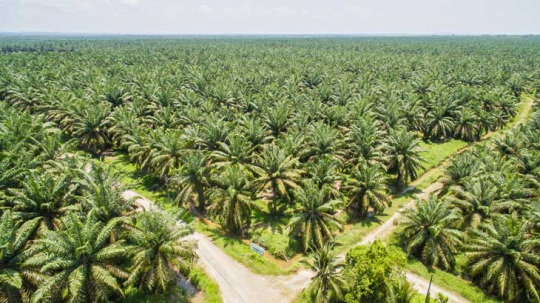
PALM PLACE Millions of hectares of once-lush, intact forest in Southeast Asia have given way to agriculture. More than 80 percent of the region’s agricultural expansion comes from palm oil plantations (shown). Credit: YUSNIZAM/ISTOCK /GETTY IMAGES PLUS
The top threat to species on land due to humans is habitat loss, the report says. About 75 percent of land on Earth has been “severely altered” by human actions. Since 1992, urban areas have grown by more than 100 percent. Elsewhere, agriculture to feed the world’s growing population has taken over many once-diverse habitats such as old-growth forests, wetlands and grasslands.
The report notes that 85 percent of wetlands that were present in 1700 were lost by 2000, and that forests now cover just 68 percent of the area they covered in preindustrial times. What’s more, the production of food crops is up by 300 percent since 1970, and in the world’s tropical regions, agricultural lands expanded by 100 million hectares from 1980 to 2000. In Southeast Asia, palm oil plantations have edged out once-intact forests, while in Central America, cattle ranches have expanded into forested areas (SN Online: 9/13/18).
2. Overfishing the oceans
Habitat loss is a problem in the oceans, too — about 66 percent of the ocean surface area has been altered by human actions, the report finds. But the top threat to marine creatures from people is overexploitation. Industrial fishing spans more than 55 percent of the ocean’s surface area, and about 33 percent of the ocean’s fish stocks are being harvested at unsustainable levels.
Among the world’s most overfished species are Atlantic halibut, bluefin tuna and all types of sharks. Other species, such as dolphins and loggerhead turtles, suffer as bycatch when they are inadvertently trapped during fishing activities.
3. Not tackling climate change fast enough
The world has already warmed by an average of about 1 degree Celsius since preindustrial times (SN: 12/22/18, p. 18). That warming is linked to the frequency and intensity of extreme weather events such as floods, fires and droughts, as well as to rising seas and to shifts in where species are distributed around the globe (SN: 1/19/19, p. 7). And warmer ocean waters are also placing stress on many fish populations, reducing the amount of fish that can be caught sustainably, without doing long-term damage to populations (SN: 3/30/19, p. 5).
Land-use changes are also tied to climate change: Land clearing, crop production and the use of fertilizers currently account for about 25 percent of the world’s greenhouse gas emissions. Three-quarters of those emissions come from animal-based foods (SN: 7/7/18, p. 10). And as a result of decreasing diversity, some tropical forests are contributing more carbon dioxide to the atmosphere than they are absorbing (SN: 10/28/17, p. 9).
4. Continuing to pollute the environment
Among the worst recent offenders is marine plastic pollution, which has increased tenfold since 1980 and affects at least 267 species, including 86 percent of marine turtles, 44 percent of seabirds and 43 percent of marine mammals, the report states (SN Online: 3/22/18).
Plastics, particularly microplastics, can find their way into soils, too (SN: 5/12/18, p. 14). And other kinds of pollution are still a problem, including untreated urban and rural waste, mining and agricultural waste and oil spills (SN: 3/17/18, p. 5).
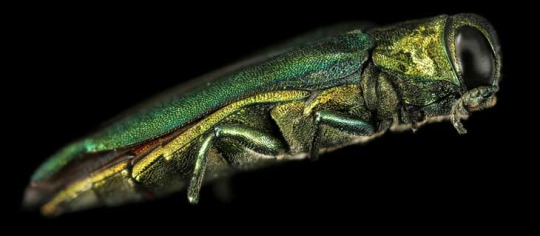
ALIEN INVASION The emerald ash borer (Agrilus planipennis) is a wood-boring beetle native to forests in Russia, Japan and China. First spotted in Michigan in 2002, these beetles have since killed millions of North American ash trees. CREDIT: USGS BEE INVENTORY AND MONITORING LAB/FLICKR5.
5, Paving the way for invaders
Thanks to global trade and travel, humans have introduced invasive species to vulnerable areas around the world: Across 21 countries with the most detailed records, the number of invasive species per country has increased by about 70 percent since 1970, the report finds. Those invaders not only compete with native species for water and other resources, but also — like the frog-killing chytrid fungus Batrachochytrium dendrobatidis (SN: 4/27/19, p. 5) or the tree-munching emerald ash borer — can wipe out vast numbers of native animals or plants.
But there’s hope …
Humans can still slow the loss of species, the researchers note. Conservation investments from 1996 to 2008 have already reduced the extinction risk for mammals and birds in 109 countries by 29 percent. But saving more species will require “transformative changes” in behavior, the report states, including how people consume energy, food and water, and how they use land and technology.
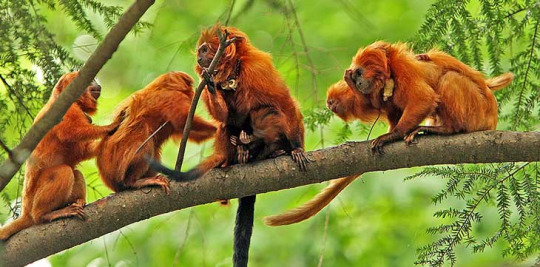
STILL HERE The golden lion tamarin (Leontopithecus rosalia) is a success story for conservationists, although the monkeys remain endangered. Their only habitat, Brazil’s Atlantic forest, is a biodiversity hot spot, but has dwindled to only a few percent of its former size due to activities including lumber extraction, cattle ranching and agriculture. By the 1960s, the primates were nearly extinct. But over the last few decades, a captive breeding and reintroduction program has helped their populations in the wild rebound to about 1,500 individuals. CREDIT: SHERSEYDC/FLICKR (CC BY-SA 2.0)
8 notes
·
View notes
Photo
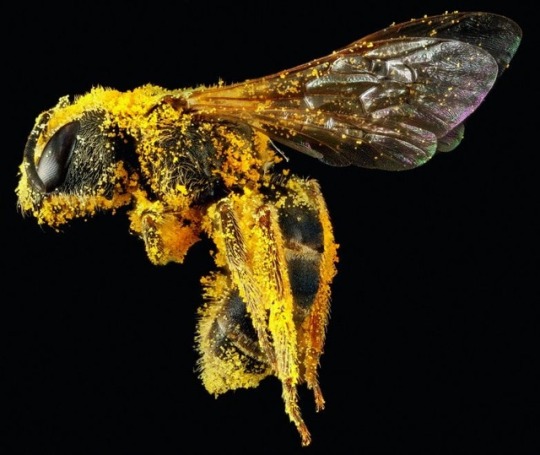
Sam Droege & USGS Inventory and Monitoring Lab, The Sweat Bee (2013)
Nell'intento di catalogare tutte le 4000 specie di api degli Stati Uniti, il capo dell'US Geological Survey Native Bee Inventory and Monitoring Programme, Sam Droege, ha puntato su tecniche di macrofotgrafia usate dall'esercito americano per stilare una guida degli insetti che potrebbero pungere i sodlati nel corso del loro servizio militare. L'Halictus ligatus in questa immagine, appartenente alla famiglia delle api del sudore, è il risultato di un incredibile collage che mette insieme più micro scatti delle parti dello stesso esemplare, così da ottenerne un ritratto ancora più chiaro
1 note
·
View note
Photo
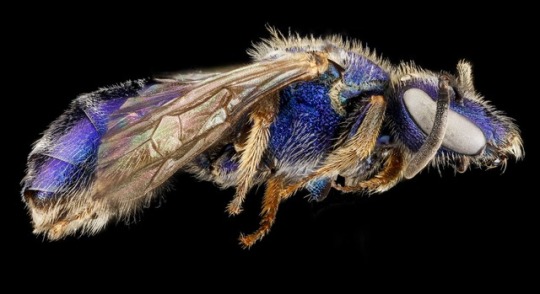
Take a peek inside the glittery world of tiny bees.
Zipping by in a flash of shimmering blues, greens, and even purples, is a member of Halictidae, or the sweat bee. Unlike the social hive behavior of honey and bumble bees, it lives a short, solitary life—collecting pollen and nectar into a sticky ball of “bee bread” for its offspring. And in the midst of tending to your garden or jogging in the afternoon, you may find this small, iridescent bee land on your arm for a quick snack of essential salts in your sweat.
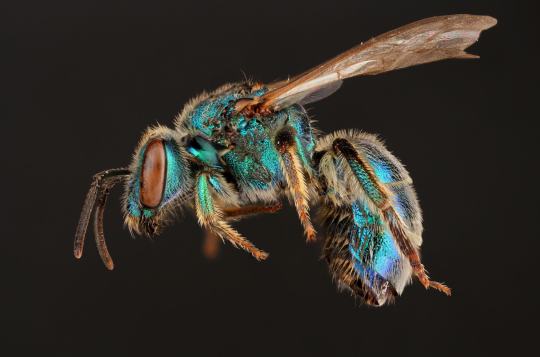
“They almost look like jewels, they just sparkle,” says Shalene Jha, a biologist and bee researcher at the University of Texas at Austin, by phone. “I always imagine that they must feel like they’re the most gorgeous creatures on the planet.”
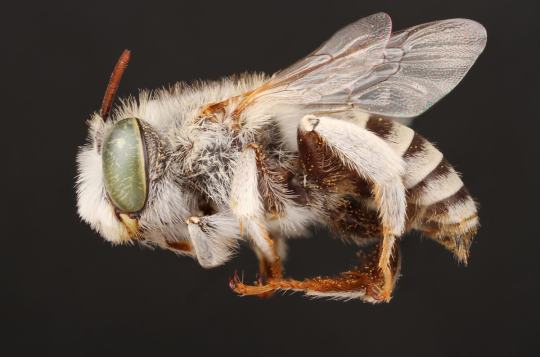
The sweat bee is just one of the many tiny bees—the size of a grain of rice or a lady bug—native to Texas that Jha and her lab studies. But these Hymenoptera gems live all around the world and are common in many environments, from temperate to tropical. In fact, there are more than 20,000 known species of wild bees on our planet, says Jha. While they may be small in size, these bees also play a crucial role in the pollination of native plants.
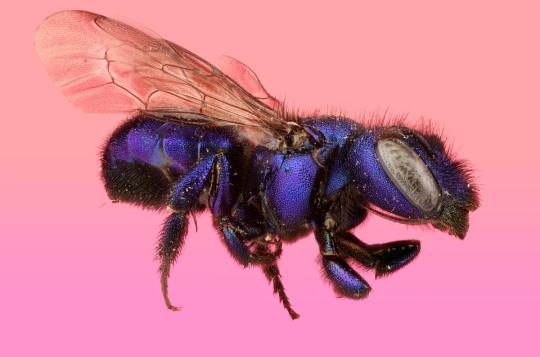
“Many people talk about honey bees and bumble bees,” says Jha. But tiny bees are also “very involved and very important in plant reproduction, both for our crops, our food items, as well as our native plant communities.”
Learn more and see these dazzling pollinators here.
Photos via Flickr/Insects Unlocked/USGS Bee Inventory and Monitoring Lab
2K notes
·
View notes
Photo
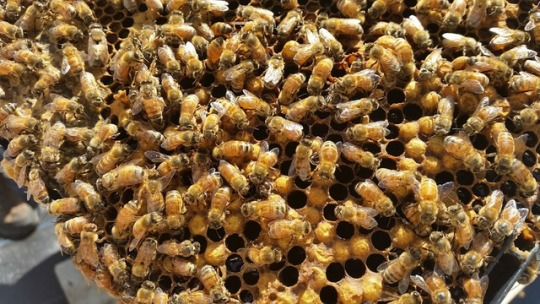
Honey bees have been having a tough time lately. Pests and disease have plagued many hives, killing off the pollinators and forcing people looking to save the bees to get creative.
One scientist in Connecticut is now pinning his hopes on bee genes -- tracking down honey bee “survivors” in the hopes of spreading their hearty DNA.
If you ever read Where’s Waldo?, you’d relate to Richard Cowles as he worked with bees.
“I call it, ‘Where’s Wanda?’” said Cowles, a scientist with the Connecticut Agricultural Experiment Station, during a recent visit to Lockwood Farm in Hamden.
As he held a frame full of busy female worker bees up to the sun, Cowles was looking for their master -- the queen. It was an early step in what promises to be a months-long experiment -- one Cowles hopes will ultimately breed stronger bees.
“What I am trying to do,” Cowles said, “is to find as many different sources of bees that have strong hygienic traits -- good survival traits -- bring them together, and then have controlled mating.”
To do that, he ordered queen bees from around the country and New England -- places like Vermont and Massachusetts. They’re honey bees with “superior genetics” Cowles said may make them better able to shake off pests and disease.
But before those new queens can go into the hive, the old ones need to come out. After a few minutes of searching, research assistant Ellie Clark (pictured below on the right) spotted the elusive queen, “Wanda.”
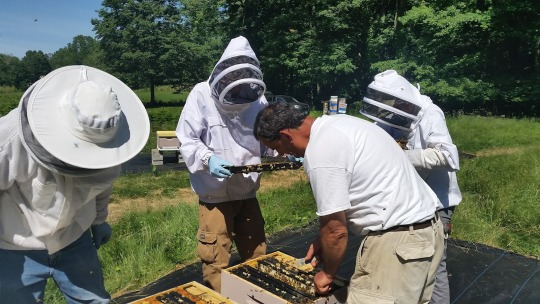
Lately, bees like Queen Wanda have been trouble. State bee inspector Mark Creighton (the guy without the bee gear pictured above) said about half of the hives in Connecticut didn't survive the winter -- and that's happened for the past three years.
“Some areas had significant losses, and others fared very well,” Creighton said. “Those in the drought regions -- especially those that just came out of drought -- they didn’t have a chance to put on adequate food reserves at the end of last year.”
Then, there’s the varroa mite. Creighton said this parasite is the number one killer of bees in Connecticut. It feeds on bees, can cripple their newborns, and spreads disease, which honey bees can pass on to other pollinators at shared flowers.
“They impact our native bees,” Creighton said. “And we want to keep all our bees healthy -- not just our Apis mellifera.”
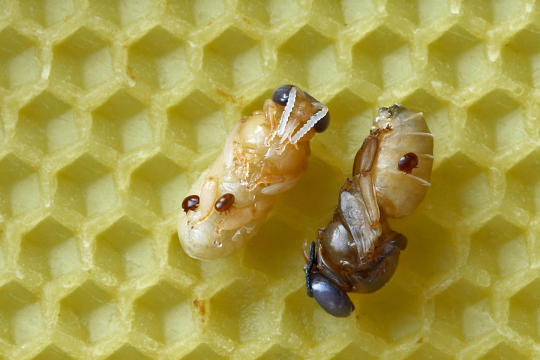
Some of the new queens of Apis mellifera -- that’s the scientific name for honey bees -- Cowles will place in the hives are specifically bred for their resilience to varroa. But he said shaking up hive leadership is a delicate process.
“You can’t just let her go, or they’d immediately surround her -- and they’d do what’s called ‘balling’ her, which means to form a mass that will heat up the insides to lethal temperature and kill her,” Cowles said.
So a queen actually gets placed into her new hive in a tiny protective box. That allows her smell to mesmerize her subjects slowly -- until the workers accept her.
And here’s where the experiment gets complicated. Like a plant breeder crossing strawberries to select for the best qualities, Cowles wants to crossbreed his bees to select for the best survivor traits.
Which means next summer, he’ll take his new virgin queens and cross their DNA with the harvested semen of lots of new male drones.
The harvest has an unhappy ending.
“There’s a weird process,” Cowles said. “You make him buzz a whole lot. And here’s the sad part. Now, let’s see if I have the technique down. I was getting pretty good at it. You gotta start from the front of the abdomen and work your way back and, hopefully, all of a sudden, it’ll go ‘pop!’”
Cowles worked the bee between his fingers, simulating what would happen to a male drone while mating with a queen. I'll spare you the details, but his technique worked.
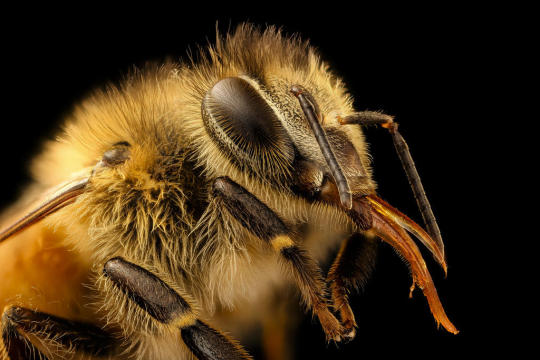
For every queen Cowles inseminates in the lab, he said he’ll need about 15 or 20 drones. And he’ll have to keep track of them all, to avoid inbreeding.
From there, Cowles will share his specially-bred bees with beekeepers in the state to see how well they survive. One hope, he said, is that the project raises awareness of the importance of acquiring well-bred bees.
“Ultimately, it’s not only for the beekeepers, and for improved survival of honey bees, but it’s also to improve the overall pollinator health in the state,” he said.
Cowles and state bee inspector Creighton said they also hope to incorporate feral populations of honey bees into their breeding program, purposefully working in one more pool of strong genes -- which will, hopefully, yield stronger bees.
(Image Credits: Patrick Skahill, WNPR / Wikimedia Commons / Sam Droege, USGS Bee Inventory and Monitoring Lab)
31 notes
·
View notes
Video
Coreopsis verticillata 3, Whorled tickseed, Howard County, Md, Helen Lowe Metzman_2019-10-23-14.20.45 ZS PMax UDR by USGS Bee Inventory and Monitoring Lab Via Flickr: Coreopsis verticullata - Whorled Tickseed. Always popular with bees, the Coreopsis group, as a whole, is widely planted, tough, and long bloomer, but reasonably rare out there in the wild, with some of the planted species not local to the mid-Atlantic. Should they be planted then. Where are the limits? Zinnias, for example, are also not native, but do occur as native species in the southwest. Nature is never very black and white. Specimen and picture by Helen Low Metzman. ~~~~~~~~~~{{{{{{0}}}}}}~~~~~~~~~~ All photographs are public domain, feel free to download and use as you wish. Photography Information: Canon Mark II 5D, Zerene Stacker, Stackshot Sled, 200mm Pentax-m with Nikon 10X infinity microscope objective lens mounted on front , Twin Macro Flash in Styrofoam Cooler, F5.6, ISO 100, Shutter Speed 200 Love for Other Things It’s easy to love a deer But try to care about bugs and scrawny trees Love the puddle of lukewarm water From last week’s rain. Leave the mountains alone for now. Also the clear lakes surrounded by pines. People are lined up to admire them. Get close to the things that slide away in the dark. Be grateful even for the boredom That sometimes seems to involve the whole world. Think of the frost That will crack our bones eventually. - Tom Hennen You can also follow us on Instagram account USGSBIML Want some Useful Links to the Techniques We Use? Well now here you go Citizen: Best over all technical resource for photo stacking stackingextreme-macro.co.uk Basic USGSBIML set up: www.youtube.com/watch?v=S-_yvIsucOY USGSBIML Photoshopping Technique: Note that we now have added using the burn tool at 50% opacity set to shadows to clean up the halos that bleed into the black background from "hot" color sections of the picture. www.youtube.com/watch?v=Bdmx_8zqvN4 PDF of Basic USGSBIML Photography Set Up: ftp://ftpext.usgs.gov/pub/er/md/laurel/Droege/How%20to%20Take%20MacroPhotographs%20of%20Insects%20BIML%20Lab2.pdf Google Hangout Demonstration of Techniques: plus.google.com/events/c5569losvskrv2nu606ltof8odo or www.youtube.com/watch?v=4c15neFttoU Excellent Technical Form on Stacking: www.photomacrography.net/ Contact information: Sam Droege [email protected] 301 497 5840
#zerene stacker#stackshot#geological survey#united states geological survey#department of the interior#droege#biml#bee inventory and monitoring laboratory#bug#bugs#canon#close-up#macro#insect#patuxent wildlife research center#pwrc#usgs#dofstacking#stacking#entomologist#canon mpe65#animals#animal#bee#bees#apoidea#hymenoptera#pollinator#nativebee#entomology
1 note
·
View note